Part B.
William Holt of Castlemaine Victoria
VICTORIA
The next group of records that definitely pertain to ‘William Holt of Bagdad’ have him located at Castlemaine, Victoria in the 1850s. On 20 July 1851 gold was discovered near present-day Castlemaine (Mt Alexander Goldfields). The Forest Creek diggings became the world’s richest ever shallow alluvial goldfield. The attraction of gold at Forest Creek led to a huge influx of gold-seekers. Once again there is more than one ‘Mr Holt’ living in this region in the 1850s. However the detailed accounts of the death by suicide of ‘William Holt of Bagdad’ on 3rd April 1858 makes it possible to identify him as being the William Holt who was sentenced three years earlier, in Castlemaine Police Court, to six months imprisonment. He may or may not have been the Mr Holt who is mentioned in the report on the meeting of miners in October 1855, but it is almost certain that ‘William Holt of Bagdad’ would have come to Castlemaine in the early 1850s because of the gold rush.
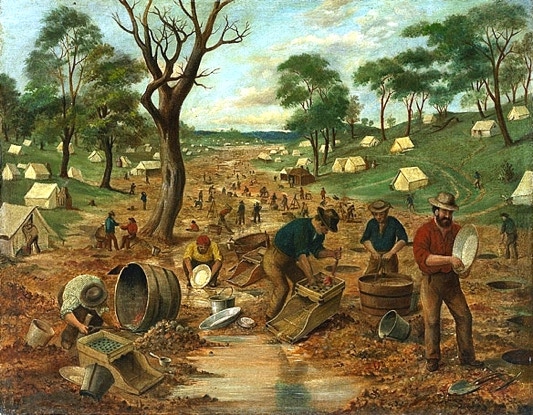
Gold diggings in Victoria, by Edwin Stocqueler, 1854 via Wikimedia Commons
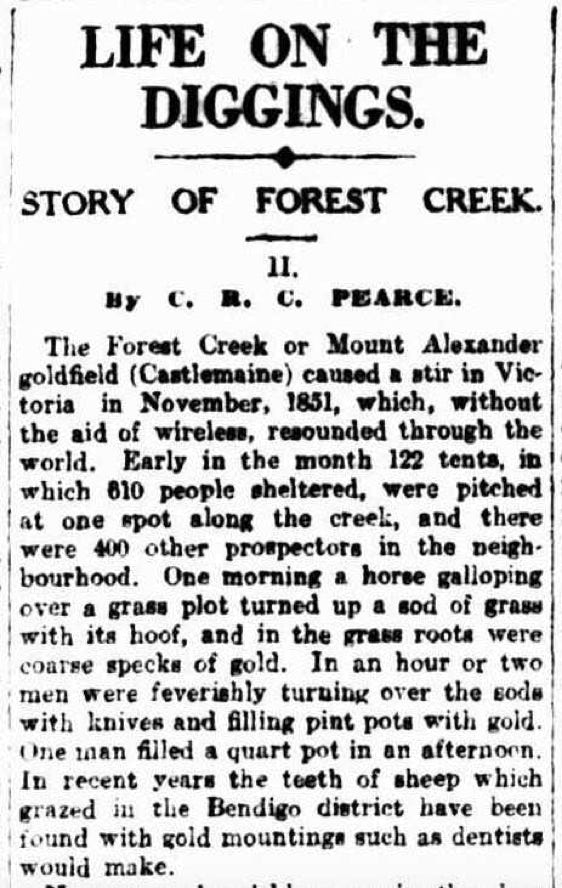
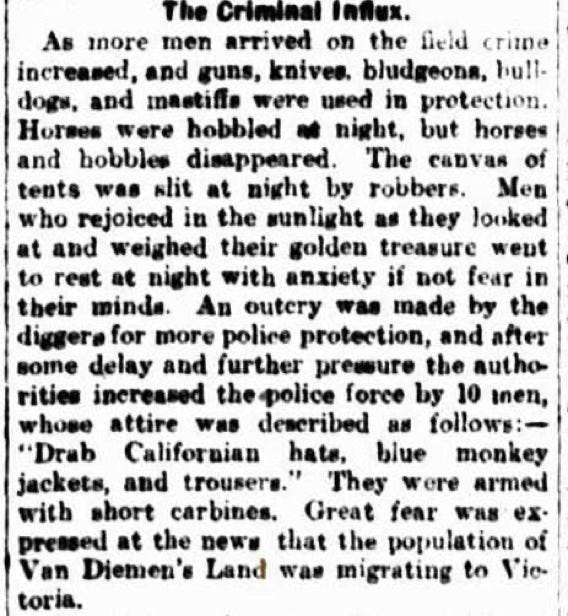
The Argus (Melbourne, Vic. : 1848 - 1957)
Sat 8 Nov 1930 Page 6
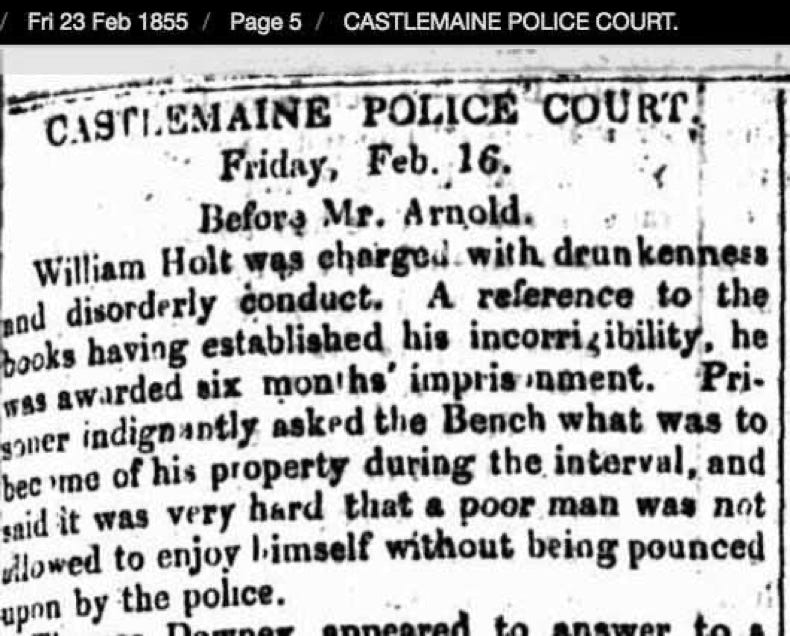
Mount Alexander Mail (Vic) Fri 23 Feb 1855 Page 5
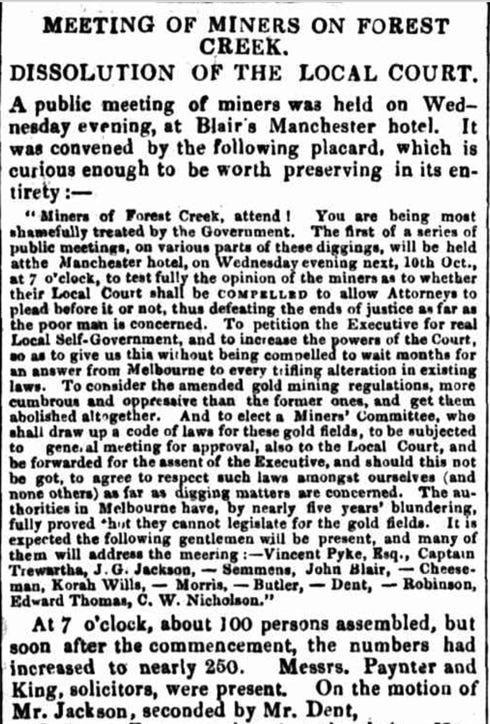
Mount Alexander Mail (Vic.) Fri 12 Oct 1855 Page 3

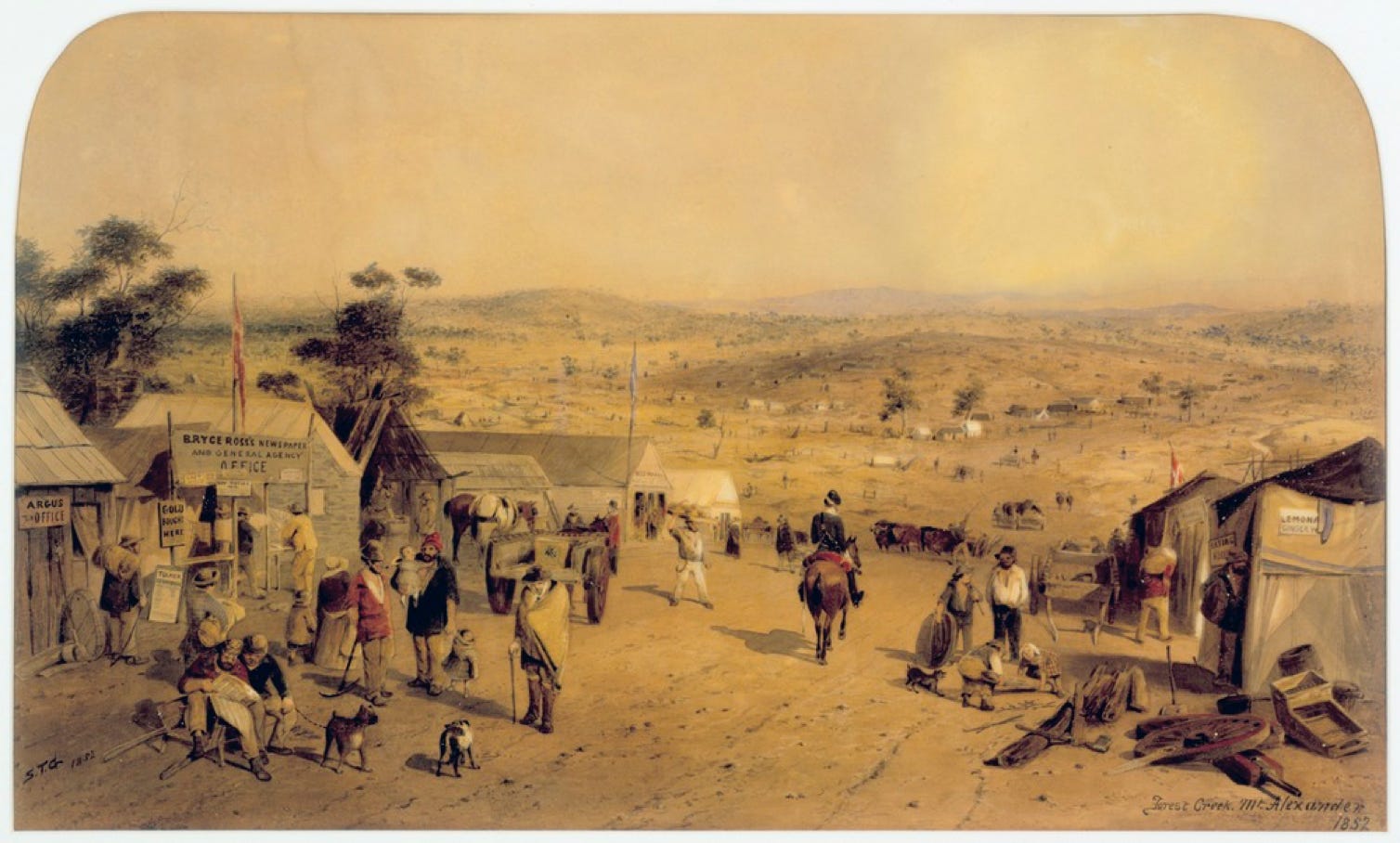
Forest Creek, Mount Alexander diggings from base of Red Hill near Argus Office looking towards Castlemaine.
July 1852 by Samuel Thomas Gill
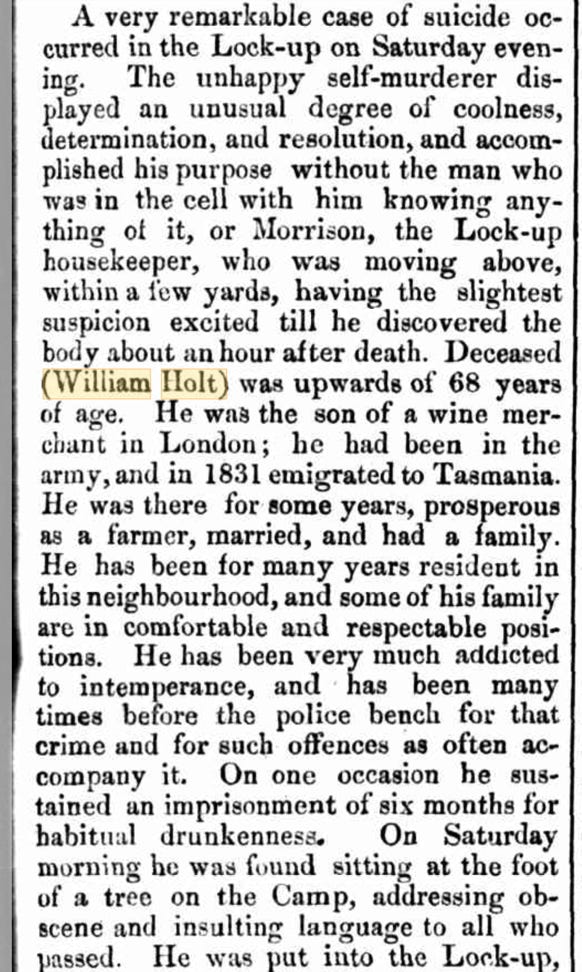

Mount Alexander Mail Mon 5 Apr 1858 Page 3
SUICIDE IN THE LOCK-UP.

The account Right, from Mount Alexander Mail, Friday 9th April 1858 Page 3, is only part of a very detailed newspaper report that was typical of earlier eras. I have included only part of it as I believe that today the original article would not only require a ‘trigger warning’, it simply would not meet present reporting standards:
"Vulnerable individuals may be influenced to engage in imitative behaviours by reports of suicide, particularly if the coverage is extensive, prominent, sensationalist and/or explicitly describes the method of suicide." Preventing Suicide – A Resource for Media Professionals, WHO, 2008 World Health Organization.
The accounts from the Mount Alexander Mail, of my great great great grandfather’s death by suicide, were also circulated in The Age (Melbourne, Vic.) Wed 7 Apr 1858 Page 6 and The Argus (Melbourne, Vic.) Tue 6 Apr 1858 Page 6.
Following up on the information that the deceased William “was the son of a wine merchant in London” I located a William Holt, wine merchant, who was living at 42 Threadneedle St London in 1817. I also located a baptismal record from the Parish Church of St Mary the Virgin in Bury, Greater Manchester, England for a ‘William, son of William Holt’ which gives 18 Jun 1790 as the date of birth.
At the time of William Holt’s marriage to Mary Ann Peters he was a 42 year old widower. In a diary reference to his man Holt, Mr Phillip Thomas Smith reflects: “I must look after him too for his ups & downs in life have been very singular”. I located an 1822 burial record from St John’s Bury for a 27 year old Mary Holt, wife of a William Holt. I also found the record of the marriage in 1812, of a Mary Robinson to a William Holt.
These records from England are not confirmed as relating to ‘William Holt of Bagdad’ but they may well be. What is known is that before William Holt even arrived in Van Diemen’s Land he had lost a wife (and possibly a child), he had served in the army, and he had a problem with liquor. He had been employed by Mr Smith to care for the valuable horses Smith was bringing to the colony. All of these horses died during stormy weather encountered early in the voyage. Soon after the Royal Admiral had arrived (on 4th April 1832), Mr Smith, who was a lawyer, was admitted to practice in the Supreme Court of Van Diemen's Land. William Holt on the other hand would have found himself without a job.
He married Mary Ann Peters on 19th June 1832, and he may have been the William Holt who attempted suicide in the Liverpool St watch-house on 18th December 1832. I have not found records to indicate whether or not William’s wife, Mary Ann, and his young sons, Frederick and Randolph, travelled from Bagdad to Castlemaine with him. Mary Ann’s sister, Elizabeth, was married to the farmer and pastoralist George Armytage (Jnr). The Armytage family moved from Bagdad to Victoria in 1847, and in 1851 they settled at Geelong. In 1859 George Armytage (Jnr) built the mansion that he called ’The Hermitage’. They are doubtless among those of the family who were “in comfortable and respectable positions”.
Grant
- GRANT - A ‘Mud Map’ history of the Grant branch.
- GRANT nee DOYLE - Ireland to Ipswich
- GRANT nee DOYLE - Working on the railway and farming at Walloon.
- GRANT nee DOYLE - Family photos in Ipswich and Rockhampton.
- GRANT/DOYLE - Cunnamulla 1903 - Hairdressing and raising a family.
- GRANT/FRAZER - Wyandra 1923 - The Commercial Hotel
- GRANT - Wyandra 1925 - A Hotel & Hairdressing, and Fishing Trips
- GRANT - Cunnamulla 1927 - A Butcher shop in a drought.
- GRANT - Brisbane - West End: Hardgrave Rd., Boundary St., and Blakeney St.
- GRANT - Toowong Cemetery
- GRANT - New South Wales - 1861 Binnalong and Harden-Murrumburrah
- GRANT/HOLT - Tasmania - Bagdad 1832 - William Holt and Mary Ann Holt (nee Peters)
- GRANT/HOLT/PETERS - Hobart 1810 - Mary Ann Holt daughter of Thomas & Mary Ann Peters
- GRANT/HOLT/PETERS - You get to choose!
- GRANT/HOLT - William Holt of Bagdad Tasmania
- GRANT/HOLT - William Holt of Castlemaine Victoria
- GRANT/HOLT - A new name and a new life.
- GRANT/GORMAN - Great-great grandma Ellen Bridget Gorman
- GORMAN - Dublin to the Dapto District
- GRANT - The Children of Frederick and Ellen Grant
- GRANT - Where the atmosphere is great.
- GRANT/HOLT Summary - Thomas Peters & Mary Ann Hews to Bernadine Monica Grant
- Grant - Doyle - Holt - Gorman - Saunders - Peters - Hews - The case is never closed.

